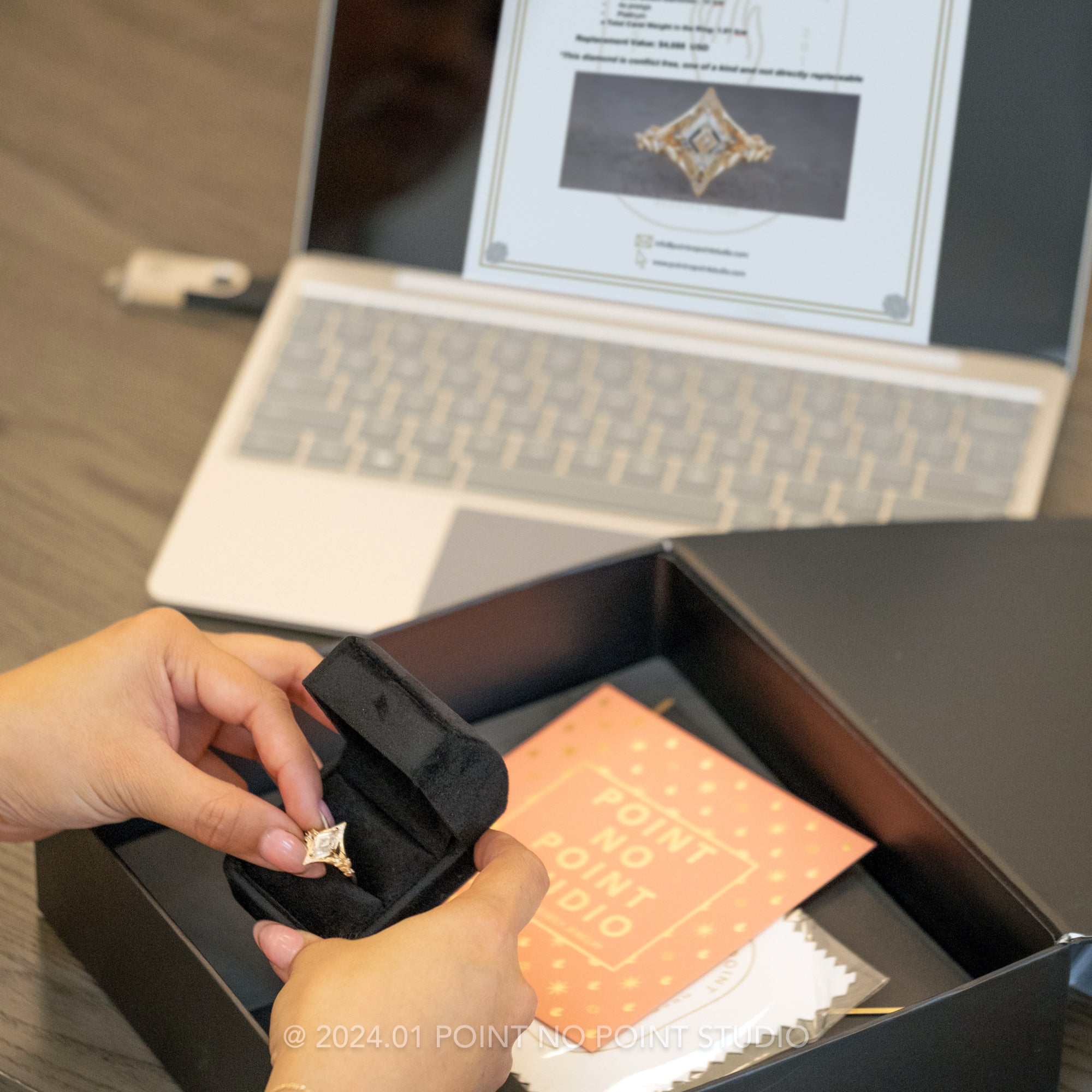Dispelling the Myths of Lab-Grown Diamonds
Myth #1: Lab-Grown Diamonds Aren’t Real Diamonds
One of the most common misconceptions about lab-grown diamonds is that they are not “real” diamonds. This is a myth; lab-grown diamonds are as real as mined diamonds - they have the same chemical composition. The naked eye alone cannot distinguish a lab-grown from a mined diamond.Once you compare them underneath a microscope, there are several key differences:
- Many lab-grown diamonds contain laser inscriptions that are only visible under magnification
- Metallic inclusions only occur in lab-grown diamonds
- Any other sort of inclusion, such as Salt and Pepper spots, are typically only found in mined diamonds
- Natural diamonds that have formed over billions of years have acquired their own markings and charm that aren’t found in the lab

Myth #2: Lab-Grown Diamonds Aren’t as Durable as Mined Diamonds
Another myth surrounding lab-grown diamonds is their durability. Lab-grown diamonds exhibit the same hardness and durability as mined diamonds, making them suitable for everyday wear. They are graded on the same Mohs scale of hardness, where both types of diamonds score a perfect 10, indicating their exceptional resistance to scratching and wear.
Beware: just because it’s a lab-grown diamond, doesn’t mean it will be perfect. Lab-grown diamond quality varies, so still keep an eye out for the “4 C’s” if you are in the market for a white diamond.

Myth #3: Lab-Grown Diamonds Don’t Have as Much Sparkle as Mined Diamonds
Contrary to popular belief, the sparkle or brilliance of a diamond is not determined by its origin. Both lab-grown and mined diamonds can be cut and polished to perfection, resulting in exceptional sparkle. The sparkle of a diamond depends on its cut, clarity, and overall craftsmanship, not if it was grown in a lab or extracted from the earth.
Ethics of Lab-Grown Diamonds vs Mined Diamonds
Environmental Impact of Mined and Lab-Grown Diamonds
Lab-grown diamonds have been touted for their low carbon footprint, often breezing over the energy consumption part. Lab-grown diamonds produce a significant environmental impact due to the amount of energy required to produce a diamond.There will inevitably be an environmental impact, so look out for transparency from your diamond dealer or jeweler. Looking for jewelers that source natural diamonds in accordance with the Kimberley Process is an excellent way to feel confident about the impact of your diamond.
The sustainability of the diamond mining industry has evolved over time, and in the past, a significant number of diamonds were wasted. Miners frequently sorted through thousands of diamonds to discover those with flawless clarity suitable for jewelry, resulting in only approximately 20% of mined diamonds being utilized. The mining process for salt-and-pepper diamonds, being more prevalent, is considerably more sustainable.
Social and Humanitarian Impact
While lab-grown diamonds have been celebrated for their positive social and humanitarian impact, the people involved in growing lab diamonds can still be subject to poor working conditions.Mined diamonds have often been associated with human rights violations, including forced labor, child exploitation, and unsafe working conditions in the past. The diamond industry has changed and continues to shift to improve ethical concerns.
To confirm that your diamonds are conflict-free, we recommend sourcing from dealers that adhere to the Kimberley Process. A requisite for all of our dealers, the Kimberley Process is a fantastic resource to learn more about conflict-free diamonds and how diamonds can be ethically mined. We have spent years finding and cultivating relationships with a select few diamond dealers who are as committed to ethically sourcing their stones as we are.
Canadian diamonds are world-renowned for their highly ethical production and traceability. All of our Canadian diamonds can be traced back to the exact mine of origin, complete with videos of the exact stone in its rough form prior to being cut and polished. Each of our Canadian diamonds also comes with a certificate of origin.
The Persistent Allure of Mined Diamonds
Financial Power of Mined Diamonds
While lab-grown diamonds offer numerous advantages, the allure of mined diamonds remains. Mined diamonds, being a limited resource, hold their value much more strongly than lab-grown diamonds. Because lab-grown diamonds can be made on demand, the initial price is lower, and the resale value is much lower than natural diamonds. Resale values are expected to continue to decrease as more product is made available on the market. The exception to this is specialty cut lab diamonds (kites, hexagons, shields, etc). Because not many cutters are willing to cut these shapes due to the amount of rough material that is lost, these shapes are harder to come by.
Unique Beauty
Natural diamonds come in a variety of colors and clarity—salt and pepper diamonds are the best example of this. These unique, one-of-a-kind gems cannot be duplicated in labs. Their distinctive features set them apart from any lab-created stone. The intricate patterns and inclusions within mined diamonds tell a story of their geological journey, adding to their mystique and charm. Each mined diamond is a celebration of nature's artistry and an enchanting treasure.
Please make sure to always do your research, and purchase salt and pepper diamond jewelry from a reputable jeweler! Many jewelers may sell salt and pepper diamonds, but they do not have the exacting standards that we do in regard to evaluating each stone for its sparkle, brilliance, beauty, character, and durability. Some jewelers are comfortable selling stones with large inclusions that impact the integrity/durability of the stone, however we inspect each stone under magnification prior to purchasing. In the case of salt and pepper diamonds, you truly get what you pay for.

Additional Resources and References
For those interested in learning more about lab-grown and mined diamonds and their ethical implications, there are various resources available. Organizations like the Natural Diamond Council (formerly known as the Diamond Producers Association) and the Gemological Institute of America provide valuable information on diamond origins, grading, and ethical practices.
Ethically Mined and Lab-Grown Diamonds from Point No Point
Since lab diamonds are easily made and can be mass produced, we can source and custom cut lab diamonds in almost any carat weight, shape or clarity. We’ve selected a few expert partners in New York and California to source our lab grown diamonds.
Salt and pepper diamonds cannot be grown in a lab – only mother nature can paint a gradient grey scale pallet. View our beautiful selection of available, loose salt and pepper diamonds here.

Are you debating lab-grown vs mined for your engagement ring? Want to learn more about our process? Then click here. Do you wish to discover more about our black diamond engagement rings? Then contact our customer service team through Zoom, phone, or email. You can also visit one of our locations to speak to one of our specialists.

